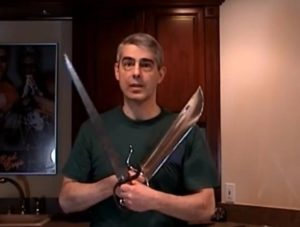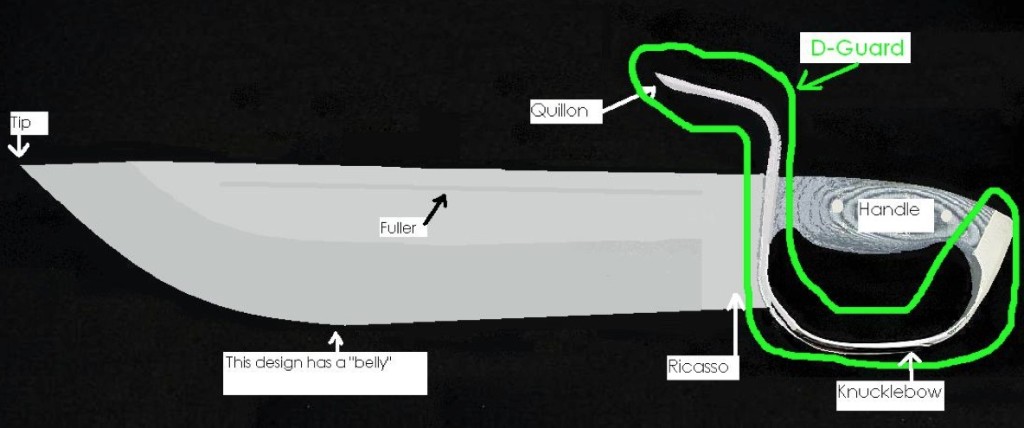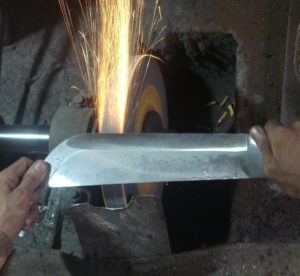Recently, I was very lucky to sit down and chat with the owner of Modell Designs LLC, Jeffery Modell. Which is the company that helped Everything Wing Chun with the design many of their mid to upper-end Wing Chun Butterfly Swords.
Before I started my conversation with Jeff, I had one main question in mind, “how does one master the art of producing great butterfly swords?” The journey of learning how to design swords is nothing like I expected. I originally thought it started with long nights in garage, hammering away at steel and similar metals until you finally figured it out. It turns out a designer of swords starts out very differently; it starts with the NEED for a good weapon.
 According to Jeff, “if you do the moves that the form is supposed to be teaching and you buy a sword that is not designed like real weapons, once you reach a certain degree of understanding, you are going to realize that they feel wrong and when you perform your arts movements, you won’t get the desired result.” In other words, once you reached a certain level of in your chosen martial art, without a real weapon, you cannot reach your full potential.
According to Jeff, “if you do the moves that the form is supposed to be teaching and you buy a sword that is not designed like real weapons, once you reach a certain degree of understanding, you are going to realize that they feel wrong and when you perform your arts movements, you won’t get the desired result.” In other words, once you reached a certain level of in your chosen martial art, without a real weapon, you cannot reach your full potential.
A simple example of having the wrong weapon would be a Wing Chun practitioner using Hung Ga swords to perform WC movements. The martial arts delivery system between Wing Chun and Hung Ga is very different. It would not make sense for a Wing Chun person who uses stabbing weapons, to train with a heavy slashing weapon that Hung Ga prefers. If you want to truly master your system, you will need the right equipment.
Many people do not realize that the type of sword you’ll need depends on the school and lineage. Jeff said that “one of the most defining characteristics of a Sword is its D-Guard. It contains a strip of steel that protects your knuckles [called the knuckle-bow]. The D-Guard is used differently by every school and lineage. Some schools do not trap or flip with their swords because they believe that combat is too fast to worry about these types of movements. They want their D-Guard to simply stop another blade from hitting their hand. In contrary, you will have other lineages that will flip between a forward and reverse grip which means the quillon of the sword has to be designed to flip without it being dropped. Some D-Guards will be designed to trap an opponent’s weapon as well as possible; others will only flip and are not intended to trap and so on.”

The challenge is finding a weapon that suits both your lineage and the needs of your personal fighting style. In Jeff’s case, once he reached certain proficiency with the butterfly swords, he discovered the weapons on the market simply “was not doing it for him.” Being that he was proactive and wanted to find a weapon that fulfilled his training needs, he commissioned two different forges to produce blades he designed.
The result? Two completely different high quality blades.
Despite sending the same design, the outcome of each set of swords was two different animals. Both blades were excellent quality, yet they both exhibited different characteristics. For Jeff, this meant he had to find a way to regularly produce the same quality and style of his weapons.
What should you consider when you finally decide to pick out a forge?
As Jeff pointed out, “you should pick someone who will do it correctly. If you decide to go with an overseas forge they often will think in terms of ‘they will get paid so much and will only put so much effort into the project.’ Try to stick with a western person with good work ethic who is willing to work on the project until he or she gets it right.”
 Always pick a forge that has good work ethics that take pride in their work. At the time when Jeff was looking for forges to produce his weapons, not many produced butterfly swords, let alone Wing Chun BJD. The forges he chose to work with were willing to put the effort into producing a top quality weapon.
Always pick a forge that has good work ethics that take pride in their work. At the time when Jeff was looking for forges to produce his weapons, not many produced butterfly swords, let alone Wing Chun BJD. The forges he chose to work with were willing to put the effort into producing a top quality weapon.
There are benefits to working with forges that can mass produce weapons at a lower price, but there are also disadvantages. If you do decide to select a forge that has such capabilities, you might be hard pressed to find one that is willing to produce a high quality weapon that truly suits your needs. Being that there will be a lot of trials and errors, you are better off sticking with local forges. In the end, you want a high quality weapon to train with, not something that is intended for mass production and does not fit any single person’s training needs.
When should you get a custom blade?
Before you start to Google for forges, you should keep in mind that in Jeff’s early stages of sword design he paid around $3,000-$5,000 for each pair of blades. Now, it would probably costs a lot more.
More importantly before you start spending money on custom designs, you should really make sure you understand what you need. Even when Jeff started, he was stuck with what was available on the market. Once he gained a high level of proficiency in his weapons training, he was finally able to identify his needs to make him a better practitioner.
It is also worth mentioning that Jeff had to work with Everything Wing Chun for 3 to 4 years until they were able to come up with the first release of their butterfly swords. Assuming you shop at a reliable store, holding off on custom blades is not a bad thing. Their experience gave them the ability to consistently make high quality, non-commercial weapons. By no means do you HAVE to get a pair of custom made blades to master Wing Chun or your chosen martial art.
If you do decide to stick with what is currently available on the market, you can obtain a great pair of swords which can give you the opportunity to further develop your art. Before you run off to the forge, you want to have a good understanding of the art you are training and the needs of your weapon.
Final Thoughts:
There are lots of sword companies out there; however only a select few produce weapons that are of high quality and custom to your needs. When you decide to pick a pair of butterfly swords, buy a pair from someone who truly understands your fighting style. From there, you will further develop your Wing Chun and will be able to make an educated decision about the swords you want to be custom made.
Kung Fu means “hard work.” Designing your own pair of custom made butterfly swords is no different. If any, there are very few mentors available. You have to be willing to put in the effort, time, and in this case, investment, until you are able to produce exactly what your training style demands.
